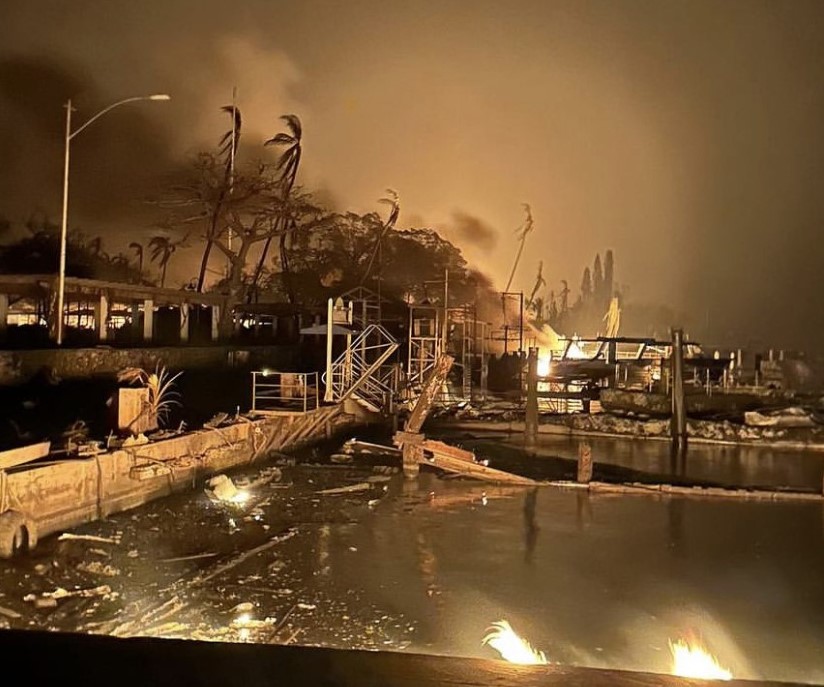
Earlier this week, Reuters reported that the death toll from the Maui wildfires reached 96, and the Governor of Hawaii, Josh Green, has indicated that number may keep climbing—by Wednesday morning they were at 106.
“I will tell you this, as a physician, it is a harrowing sight in Maui,” Governor Green stated. “When those providers, the police and this division, do come across scenes in houses or businesses, it is very difficult for them because they know, ultimately, they will be sharing with our people that there have been more fatalities. I do expect the numbers to rise.”
The most serious blaze swept into Lahaina last week on Tuesday and destroyed nearly every building in the town of 13,000, the Associated Press reported, leaving a grid of gray rubble wedged between the blue ocean and lush green slopes.
“Everybody has their story, and everybody lost something. So everybody can be there for each other, and they understand what’s going on in each other’s lives,” stated one island resident.
And these stories are still unfolding. As Reuters reported, many local residents unable to get in touch with missing family members have taken to social media to put out their messages.
“Still searching for my in-laws,” Heather Baylosis wrote in a Saturday Instagram post. “People are being found alive and severely disoriented due to what they have gone through. We are holding out hope!”
Meanwhile, Megan Sweeting wrote on her Facebook page, “MISSING: My Dad, Michael Misaka, has been missing since the Lahaina Fires started. If there is any information out there regarding my dad, please let me know. I just need to know he is safe.”
ABC News checked in with employees at the Nakamura Mortuary in Wailuku, Maui, where the loss has hit home in an unimaginably painful way. Before they can get to the difficult task of burying the dead and grieving for them, they must first resolve the whereabouts of their own missing family members. One concerned employee told ABC she was still in shock and unable to reach family members in Lahaina. “We’re still trying to gather ourselves,” they said. “It’s still very fresh.” They explained that their own relatives had lost their homes, and as of earlier in the week, family members were still missing—they were last seen in Lahaina and as of earlier this week hadn’t been heard from in 48 hours.
There were other ways that deathcare and the processes of the funerary cycle were affected. And it isn’t just homes and property and lives that were destroyed; in some cases, lives that had already been lost were lost again. Wailuku resident, Kimo Kirkman, explained to NBC News that of everything he lost in one of the devastating fires on the island of Maui last week, surrendering his father’s ashes was the worst. “I wanted to hold on to it forever,” Kirkman told ABC, as his voice quivered with emotion. “Now he’s just in the ground with all the other ashes.” He added: “That was my only prized possession…That was it. You know, all the other stuff was, that didn’t mean anything.”
Hawaii’s Attorney General, Anne Lopez, said last week she was opening a probe into the handling of the wildfires.
It was just a few weeks ago that Digital Dying reported an article on how deaths from extreme heat are getting more and more common in our current age.
News reports on the Maui fires have also pointed out that this deadly disaster stands even above others which at the time broke records and were utterly tragic, such as the 2018 Camp Fire in northern California, which left 85 dead and destroyed the town of Paradise. The Guardian reported that Lahaina has now seen the largest number of deaths from a wildfire in the US since 1918, when 453 people were killed in the Cloquet fire in Minnesota and Wisconsin, according to the National Fire Protection Association.
A local Minnesota news station ran a story earlier this week on that fire, stating that “the heart-wrenching disaster in Maui is conjuring up memories of a dark time in Minnesota history.” The Cloquet fire, news station KARE 11 reported, “claimed more than 450 lives in northern Minnesota” and was “the largest natural disaster the state has ever experienced.” This “series of fires…burned for weeks through Duluth, Moose Lake, Cloquet, and Kettle River. It destroyed 38 communities and blackened 250,000 acres, fueled and pushed by 76 mph winds…some people crawled into their cellars and were trapped by the flames. Others tried to drive away or run into area lakes, just as some residents of Lahaina ran into the ocean in Hawaii.”
The worst death toll from a US wildfire, according to the National Fire Protection Association, is 1,152, from the Peshtigo fire in Wisconsin in 1871. It is worth examining the National Weather Service’s webpage on this fire, which explains the fire occurred during a particularly dry summer and the same night as the infamous Great Chicago Fire, which was begun, at least according to myth, by a cow tipping over a lantern. Some survivors say the Peshtigo Fire moved so fast it was “like a tornado,” according to the National Weather Service page.
The fire scorched 1.2 to 1.5 million acres and burned 17 towns, but the damage in Peshtigo was the worst. “The city was gone in an hour. In Peshtigo alone, 800 lives were lost,” states the webpage. “The fire produced countless stories of heroics and tragedy…There’s the story of a man carrying a woman to safety he thought was his wife. When he found out it wasn’t her, he went crazy. People said the Peshtigo River was the only haven from the fire, and one 13-year-old German immigrant girl said she held onto the horn of a cow all night in the river to survive.”
Back in Hawaii, all eyes remain on the present moment, the continued search for survivors, the painful processes of grief and loss, and eventually, of healing. On Sunday, Reuters reported many residents of Maui found that consolation in church.
“Many of the survivors took to Sunday church services, including Akanesi Vaa, 38, who said her family got stuck in traffic while trying to escape the flames,” Reuters reported. “Vaa, her husband, and her children, aged 15, 13, and 9 fled on foot and jumped a fence to safety. Along the way, an elderly woman pleading for help handed her a baby to care for. The woman and her husband also made it over the fence.” The family attended Sunday services at King’s Cathedral in Kahului, on the other side of the island. “I think a lot of us needed to hear today’s message,” Vaa said after the services.
“All these ashes are going to turn into beauty,” she said. “I know Lahaina will come back ten times stronger.”









